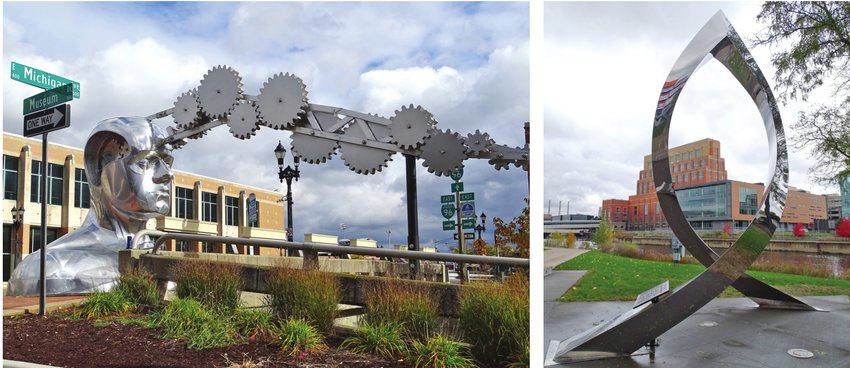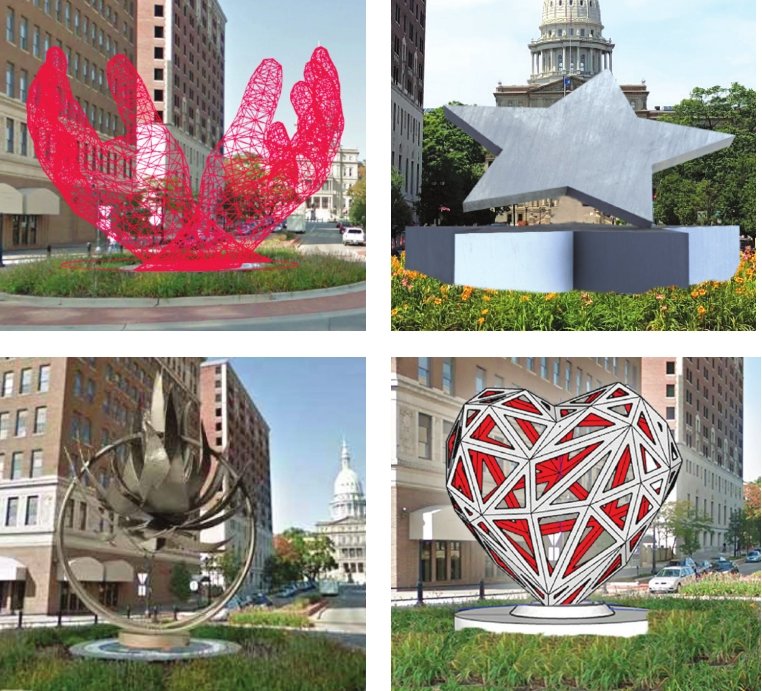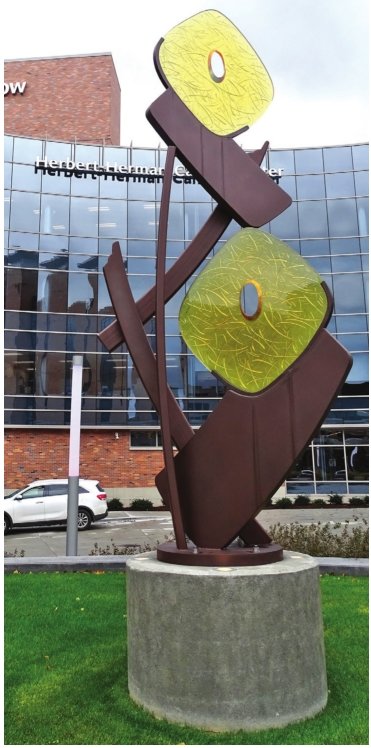 Last month, the unveiling of four proposed sculptures sparked a fresh discussion about public art in Michigan’s capital city.
Last month, the unveiling of four proposed sculptures sparked a fresh discussion about public art in Michigan’s capital city. The arts community was overwhelmingly underwhelmed by four generic, emoji-like designs for a sculpture in the roundabout east of the state Capitol, where Washington and Michigan avenues meet.
The roundabout is a prime, convention-and-tourist-brochure spot, with the Capitol dome in the background.
The Capital Region Community Foundation is managing and funding the project, budgeted at $100,000.
One of the designs, #LoveLansing,” is a giant, metal-framed heart by Washington, D.C.,-based artist M.L. Duffy — one of several hearts the same artist has deployed on streets and plazas in Oregon, New Jersey, Colorado, Georgia and Florida.
Illinois artist Mark Horst proposed a pair of welcoming hands made of wire frame.
A third design, “Flame,” by Minnesota sculptor James Gabbert, is more distinctive: a stylized flame, resembling a metal artichoke, hugged by two rings representing the state’s two peninsulas.
“Star Born,” by the Lansing-based team of David Such and Fred Hammond, is the blandest or boldest of the bunch, depending on your point of view. In theory, a magnified version of the star that marks Lansing as the state capital on maps is a cute visual pun, like painting a giant dotted line on the border between Michigan and Indiana. To the viewer, however, it’s a just big, flat star.
Public feedback solicited on the Community Foundation’s website, and in informal discussions with arts people, has been mixed at best.
“We expected the negative feedback and we respect it,” foundation vice president Laurie Baumer said. Baumer was also on the panel that whittled the 72 submissions received to the final four. “Some of it has helped us see the pieces in new ways,” she said. “We may or may not come out with a finalist. We see there’s more we might need to do.”
If the foundation’s selection panel — which was scheduled to meet today on making a recommendation — decides on a finalist, it would go to Lansing Mayor Andy Schor for approval or veto.
“Ultimately, it’s in his hands,” Baumer said. But Schor kept his welcoming hands folded. He cautiously avoided criticizing or endorsing any of the finalists.
“I’ve heard a lot of different things,” Schor said.
“There are people who love them and people who hate them. I’m hearing a lot of comments, and I’ll evaluate all of them.”
Schor said he’d like to see the foundation reopen the process for more submissions. He’s also asked that all 72 original submissions be made public.
“Questions are coming up,” Schor said. “I’d like to see a little more transparency in the process.”
At $100,000, the roundabout sculpture is budgeted near the low end of similar sculptures around the country. Not far from the roundabout, “Inspiration,” a stainless steel sculpture by James T. Russell installed in 2010 on the banks of the Grand River near the City Market, cost over $300,000.
But Schor ruled out any city contribution to the sculpture.
“We’re not putting taxpayer dollars in,” he said. “If there’s others out there who want to add to the pot, we’ll take that, but nobody has called and offered us another $100,000.”
REFLECTION VS. VOICE
Picking a big piece of public art is a tug of war.
At one end are the civic and business leaders, the “placemakers” who are often funding the art for economic reasons. They want the sculpture to speak for the whole community, offending as few people as possible, and also look smashing on a brochure Since 2016, the Community Foundation has made “place-making” its “current strategic focus,” Baumer said. “Before we started working on this project, nobody seemed to care that a prime piece of place-making real estate was devoid of anything interesting,” Baumer said. “This is the worst kind of statement about Lansing.”
“We want it to be something that’s actually reflective of the city,” Schor said. “It’s a very visible place for residents and visitors.”
At the other end of the tug of war are arts professionals — artists, gallery owners, museum curators, academics — who value the artist’s individual expression above all.

“One of the key factors we look for when adjudicating for any art project or program is artistic voice,” Lansing Art Gallery director Barb Whitney said. “We seek in the work a reflection of the artists themselves, a distinctiveness in their product.”
There’s no mistaking a Jeff Koons, Whitney said, for anyone else’s work.
“And yet, a lot of the public art programs are seeking something that distinctively represents their community,” she said. “It's an interesting conundrum.“ Schor seemed to favor the latter view. “It’s not about respecting the sanctity of the art, it’s about representing the city,” Schor said.
The tug of war plays out differently in different cities.
Sometimes the artist’s voice is so strong the sculpture muscles its way into becoming a civic icon.
At first, many residents of Grand Rapids hated “La Grande Vitesse,” Alexander Calder’s 42-ton “stabile” made of sharp red steel fins, but it has since became a ubiquitous icon of billboards and brochures, and even appears on the city’s logo.
“When you think of an iconic sculpture like the Calder in Grand Rapids, it has helped define Grand Rapids and not vice versa,” Whitney said.
Nor is there anything inherently Chicago-ish about Anish Kapoor’s famous “Cloud Gate,” the giant beanshaped sculpture in Millennium Park — no hint of meat packing, chilly winds or the blues — but its audacious, balloony playfulness has turned it into an icon of the city.
Detroit’s Joe Louis monument, an enormous fist punching through downtown traffic as it dangles from a tripod, is a rare threefer — a strong, distinctive statement by artist Robert Graham, a fitting tribute to the legendary boxer and the embodiment of a city’s defiant spirit. It’s a civic and artistic punch that’s hard to shake off.
Whitney has served on art juries and has done a lot of thinking and research about what kind of public art works best and why. This summer’s display of smaller sculptures along the Lansing River Trail, sponsored by the gallery, was a rich mix of visual appeal, unique concepts and thought-provoking work.
“Excellence within the art should be the priority, first and foremost,” Whitney said. “The best public art across the country, and the case studies we’ve looked at — they can drive all kinds of attractions and help the economy around the work, but the economic piece should be a by-product of the excellent art.”
Whitney was careful not to directly criticize the four roundabout finalists. (The Community Foundation is a major supporter of the Lansing Art Gallery.)
But the selection panel for the roundabout sculpture was clearly driven by place-making professionals and not artists.
At first contact last week, Baumer declined even to name any of the panel members.
“They are volunteers, and given the nature of the criticism that I think has been unfortunate, I think it would be wrong to name volunteers,” Baumer said.
A day later, after asking the members, she got the OK from most of them to be named: Baumer, Debbie Mikula of the Arts Council of Greater Lansing, Josh Holliday of the Lansing Area Economic Partnership, Samantha Harkins from Schor’s office, and Julie Pingston, vice president of the Greater Lansing Convention and Visitor’s Bureau.
Baumer said there were also artists on the committee, but they declined to be named.
Public feedback was solicited, Baumer said, but “it’s not a popular vote and it’s not a juried selection. It’s kind of a hybrid.”
ROUND ABOUT ROUNDABOUTS
A quick Google search will turn up dozens of examples of roundabout sculptures around the world — everything from a giant thumb (Marseille) to an Olmec head (Madrid) to three Porsches zooming in the air (Stuttgart, Germany).
All of them deal differently with requirements unique to a roundabout. In addition to meeting artistic goals, they have to be visible from far away without blocking drivers’ view of traffic. Many of them use inventive transparency tricks to square that circle.
“Beacon Bloom,” in Carmel, Indiana, is a bouquet of stylized flowers on tubular steel stems forming a 32-foot fountain of Queen Anne’s lace. It’s visible from two miles away but looks surprisingly delicate up close. The flowers and stems seem to move as you move around them. At night, the piece is delicately lit up by 800 LED lights that “use less electricity than a can opener,” according to artist Arlon Bayliss’ website.
Barb Whitney is a fan of “She Changes” (also known as “the anemone”), a 2005 sculpture by Janet Echelman. A giant circle of steel holds a colorful net that billows directly over a traffic roundabout in northern Portugal. The sculpture is both a living, moving work of art and a tribute to the seaside area’s fishing industry.
Michigan storms would probably shred Echelman’s creation pretty quickly, but that’s not the point. The right vision, Whitney said, could turn the Lansing roundabout into something extraordinary.
“It’s really special to have that experience of coming off the freeway, driving down Michigan Avenue and seeing the Capitol,” Whitney said. (Her own drive to work gives her that thrill every morning.) “Having that centerpiece in the roundabout in front of the Capitol is something really special and unique and distinctive to our community, and it could be a really magical piece of public art.”
THE ONES THAT GOT AWAY
When it comes to public sculpture, Lansing is still living down the story of epic landscape artist Michael Heizer’s “This Equals That,” the nation’s largest outdoor sculpture in 1980, when it was installed on the plaza west of the Capitol. The massive half-acre work, with a steel framework brought in by helicopter, consisted of a pill-shaped cylinder 6 feet thick and four other partial “pills” 12 feet across, abstractly arrayed to evoke a lotus flower and embody the geometric equivalence of the whole and its parts.
The sculpture drew visitors from around the world, but it wasn’t embraced in its hometown. In 2002, it was dismantled, at the behest of then-Gov. John Engler, on the pretext that it was falling apart and causing damage to the parking structure below.
According to one estimate, restoring the sculpture would have cost $1 million, but it cost about half as much to take it apart. The will to fix it just wasn’t there.
John Truscott, a former press secretary to Engler, expressed a widespread view in a radio interview on WKAR in December 2003: “It looked like something that an elementary school kid could have done.”
In a Nov. 18, 2002 editorial, the Lansing State Journal said what Lansing needed was “a little more Norman Rockwell, and a little less Picasso.” That same year, the Journal ran a guest column by retired LSJ reporter John Albright, “Send sculpture to the dump.”
In the early 1970s, Swedish-American sculptor Claes Oldenburg, known for his enormous sculptures of everyday objects, was commissioned to create a sculpture in Lansing. None of Oldenburg’s designs – a giant baseball mitt and ball, a Good Humor bar made of letters of the alphabet, an ashtray and a giant saw — saw the light of day in Lansing. Oldenburg withdrew from the project in 1973.
All of the sculptures, except the ashtray, were built in other cities. Oldenburg’s sculptures are still major attractions in the cities that have them. Whitney recently had a memorable encounter with Oldenburg’s giant spoon and cherry in a Minneapolis sculpture park.
“It’s massive,” Whitney said. “We had to pose with it, just like the tourists. It’s part of the city’s heritage now. If we had gotten an Oldenburg … .”
SCULPTURE SURGE
It’s hard for a sculpture to please everyone and still mean anything, but Lansing already has a few conspicuous examples that give it a whirl.
The privately funded “Inspiration,” near the City Market, cost $375,000, including Russell’s $225,000 fee — $75,000 over the expected budget, due mostly to the cost of its concrete footing.
(One of the sites originally considered for “Inspiration” was the Washington/ Michigan traffic circle.)
The piece has been a success by many measures. It has few haters, or at least vocal ones. On most nice days, curious River Walk strollers stop to take selfies, hop through the loop and lean on its inviting curves.
While in Lansing, Russell said his formula for public sculpture is to avoid specific subject matter and go for a “timeless” look.
“You need something that will still look new at the 200-year mark,” Russell said.
The late Circuit Court Judge Michael Harrison, who headed the selection committee, insisted that quality be the highest priority, bucking others who argued that the choice had to be a Michigan sculptor.
A few blocks east of the roundabout, a giant aluminum and steel head looms over Museum Drive, with gears springing out of its forehead and extending downward from Michigan Avenue. Installed in late 2017 as part of the city’s Arts Impact Project, the two-ton, $75,000 “Portrait of a Dreamer” by St. Johns sculptor Ivan Iler instantly livened up a formerly nondescript intersection while pointing motorists toward the museum district just to the south of Michigan Avenue.
Iler is on deck to create Lansing’s next big piece of public art, the “Gateway to Inclusion” project sponsored by the nonprofit Peckham, Inc. and the Capital Region International Airport. The $175,000 project will go into the median of Capital City Boulevard, adjoining both Peckham’s headquarters and the airport in the northwest corner of the city, with construction to begin next summer.
There is yet another major public sculpture in the works for next year, part of a plan to revitalize the South Lansing intersection of Holmes and Pleasant Grove roads, funded by a $75,000 grant from Lansing’s Arts Impact Project.
Meanwhile, Whitney said the Lansing Art Gallery plans to double its already ambitious Art on the River sculpture project next year, doubling the 3-mile stretch of River Trail and nine sculptures the project put along the river this year.
To bring the saga full circle, even “This Equals That” is getting fresh buzz in 2018. Recently, MSU Museum director Mark Auslander and Broad Art Museum associate curator Steve Bridges have publicly discussed restoring or reviving the epic sculpture and bringing it back to Lansing, but its whereabouts are still unknown. The framework was chopped up, left in a field and last seen years ago in a Detroit warehouse.
With so much public art going on in Lansing, the proposed roundabout sculpture could put an Oldenburg-scaled cherry on top, but Schor said there is no rush.
“If the foundation is willing to re-open it, we’ll take a look, in a public way, and see what the submissions are,” he said.
“We have an Arts Commission, and I’d love for them to have a review. I’d like the right people to put eyes on it and comment on the process.”
Baumer said the selection committee might even beat Schor to the punch and recommend “none of the above.”
“Maybe we go back to the drawing board and maybe we don’t,” she said. “It could come down to the same four, but we’ll see.”
Schor knows only one thing for sure — some people won’t be happy with the result.
“Art is always controversial,” Schor said. “That’s why it’s art.”
Support City Pulse - Donate Today!
Comments
No comments on this item Please log in to comment by clicking here